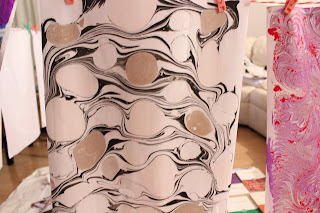Today my post is dedicated to Secret Belgian binding.
This type of bookbinding is very recent, specially comparing to other
techniques of bookbinding. It was invented in the mid 1980s by Anne Goy.
Her goal was to make an occidental version of the Japanese bookbinding
that could open flat.
The panel consists of three parts: two covers and the spine that are sewn together. The signatures will be sewn to the threads that cross the interior part of the spine.
This type of bookbinding is very comfortable; it not only opens flat, but there is also no limit in the number of pages or the size (unlike, for example, the Japanese bookbinding that can be difficult and uncomfortable to open if it's very small). Moreover, since the union of the panel is made by thread, we can use paper to cover it all and we don't have to be afraid that this paper, as time goes by, will break and our covers will be separated from the spine.

























































